www.webmineralshop.com |
Norway 2002 A
Mineralogical (and touristic) trip |
 www.smartminerals.com |
www.webmineralshop.com |
Norway 2002 A
Mineralogical (and touristic) trip |
 www.smartminerals.com |
Norway, Summer 2002
A summary of a Mineralogical (and Touristic) Trip
(visit our galleries in the Scandinavian section on Smartminerals.com, next update around middle of September )
Norway is a wonderful country for its marvellous nature that you may enjoy everywhere. For conventional tourists the most famous attractions are the world famous fjords, the fantastic waterfalls and the icecaps of Fjordland and Nordland, the forests of Telemark and Oppland as well as the crazy landscapes of Lofoten Island with their granite peaks elevating directly from the sea at 600 - 700 m.
Also for a mineralogical tourist Norway is a fascinating and..... difficult country. Due the scarse population and the huge open territory a big potential for minerals still exists in Norway. But the vegetational coverage, the complex topography, the lack of access roads or marked tracks makes the localisation of the sites very difficult.
In few words looking for minerals in Norway requires expertise, time (a lot !) and patience (again a lot !) . Most of the locations are old quarrys, dumps, mines or small trenches and small dumps abandoned since several years. The dense vegetation makes very difficult to localise the sites (a GPS is recommended if you know the location coordinates) and the high water table most of the time causes the filling up of the old works. Of course things may be easier if you have friends that kindly show you the location or join you in the mineralogical excursion. Again this is possible but requires time and patience since you need to contact the rigth Norwegian mineralogists, speak with them, establish friendships and cooperation. I have to say that most of the Norwegians mineralogists we met were really kind and cooperative once you have establish the right network with them.
Please, if you are interested to collect in Norway remember that most of the times permits from the land owners are required to collect minerals on their own properties. Some quarrys are open for collecting (such those of Langesundfjorden but you have to go there after working hours or during the weekends. Again most of the active quarrys again requires permits from owners to allow collecting.)
Our trip (see Map1) started from Egersund where we arrived with the ferry from Denmark and then we drove to Stavanger just to visit the famous Preikestolen (see fig. 1,2) and goes through to the North driving in the Fjord area, crossing the Hardanger and the
2002 Trip and main visited areas and localities ..........
|
Map 1 2002 - Mineralogical and Touristic Trip to Norway |
|
|
Fig.1,2 - The Preikestonen ("Pulpit Rock") standing 600 m over Lysefjord in a wonderful sunny day
Jouthoneim and then heading north passing through Trondheim, Mosjoen, Mo i Rana, Fauske, Bodo, Lofoten, Harstad, Narvik, Alta, Seiland (see red dashed line on map 1) and then back to the south (see green dashed line on map 1) visiting Oppdal, Krøderen, Modum and Drammen areas and finally Konsberg, Nissedal and Evje, Iveland Area . The trip lenghts 20 days and several locations have been visited. Some of the mineralogical locations we looked for have not been found (also if coordinates where available). After a visit to thebeautiful Bergen (recommended!) we drove to Voss, the Sognefjord and the Lustrafjord (see fig.3,4)
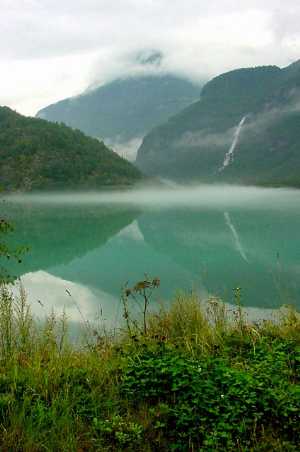 |
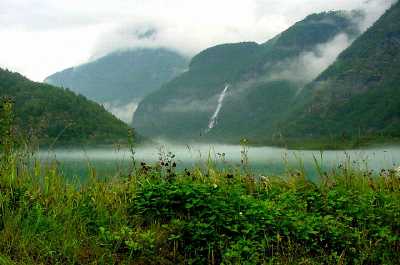 |
Fig.3,4 - The Lustrafiord in a foggy end July morning
and then crossing the Jotunhein Park to Lom. Here we stop to visit the Fossheim Steinsenter owned by Torgeir Garmo one of the prominent Norwegian Mineralogists. We made some purchases and trades and then we head to north stright through Dombas, Trondheim, Mosjoen, Mo i Rana, The Polar Cirkle (fig.5),
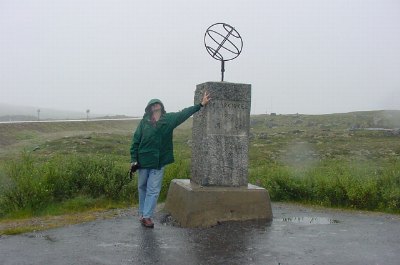 |
Fig.5 Crossing the Polar Cirkel (66O33' North) between Mo i Rana and Fauske in a rainy and cold day
Fauske and Bodo. From Bodo (fig.6 and 7) we took the ferry to the Lofoten Islands to make some tourism before the mineralogical trip start. Lofoten is a lovable place, we have to say.
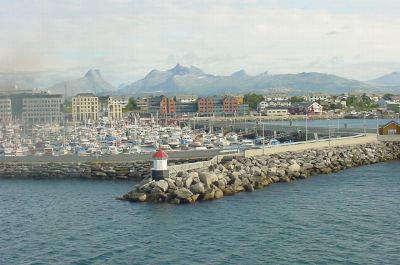 |
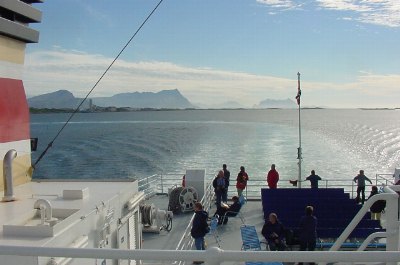 |
Fig.6,7 - Leaving Bødo for the Loføten Islands
We enjoy every minute of this three days visit in Lofoten especially those spent in the southern parts of the arcipelag in the Møskenoya Island (Fig. ,8, 9, 10, 11). Here you can just hear the silence (yes!) and the birds voices and relax yourself thinking at the crazy places where we spent most of our stressfull lifes (Milan in Italy for us). Take your time and enjoy at the Lofoten; there are not enthusiastic mineral locations (also if some Pegmatites outcrops occurr) but also without minerals the places worths a long stay ! Walk, fish, climb, look around and relax yourself....
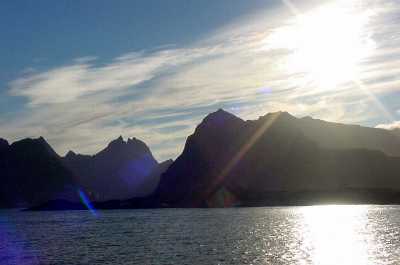 |
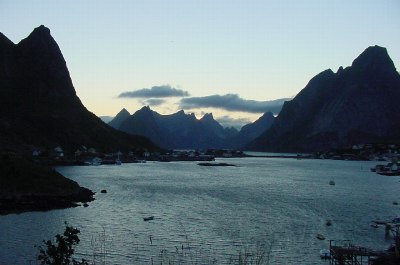 |
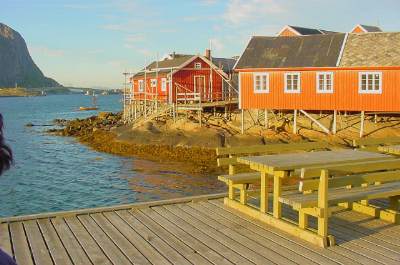 |
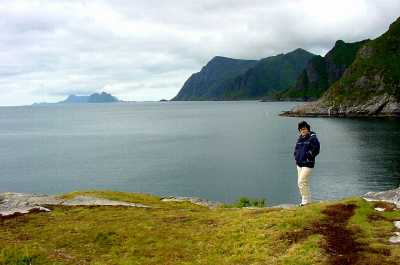 |
Fig.8,9,10,11 - Lofoten Islands, pics from Reine and Å i Loføten in the beautiful Møskenoja island
After the stay in Lofoten we drove to Harstad and then to Lodingen where we took the Ferry to cross the Tysfjord. This is a rich area for minerals and is here that our mineralogical summer started. In four days spent we visited several localities in the Hamaroy , Ofoten and North of Fauske (see location 2 and 2 bis on initial map) area often with good luck for collecting. In these areas there is a complex geology . In the Hamarøy area medium and high grade metamorphic rocks outcrop and there are several localities where you can find several types of garnets. We spent two days collecting at the Almandine and Spessartite garnet localities in Hamarøy area with some good luck also if we spent more than two days before we localise the collecting site for the Spessartite (fig.12,13) . In the same location nice Magnetite xls also occur also if rarely. The localisation of the Almandine site, North of Fauske, (Fig.12 ,13) was much easier and we were able to collect some nice samples . The Pyrope location requires two-three hours walk and the amount of specimens you can take with you is of course limited to your physical resistance while the Almandine site requires just 15 minutes walk from the parking area.
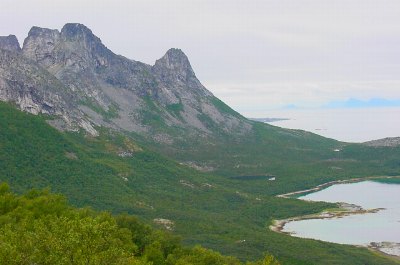 |
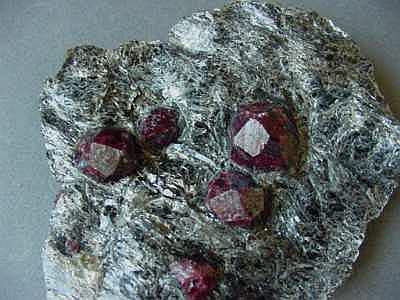 |
Fig.12 - A view to the Garnet locality, near Tysfjord, Hamarøy - The Lofoten Islands on the back
Fig. 13 - A nice gemmy deep red Garnet specimens from Tysfiord (xls up to 1,5 cm)
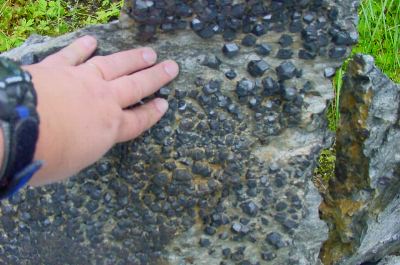 |
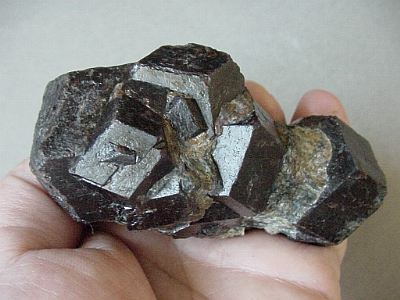 |
Fig. 14 - The Garnet Almandine collecting locality, North of Fauske, Nordland. Garnet xls in outcrop in micashists
Fig.15 - A nice 9 cm group of Garnet Almandine xls on matrix , North of Fauske
The next two days has been devoted to localise the Thalenite (an extremely rare Yttrium silicate) locality in Tysfjord . We knew that the locality is exhausted since long time ago but we decided to try the same. We were able to localise the site and also lucky since after two days of hard work we suceed in collecting at least 20 remarkable specimens of Thalenite xls embedded in Yttriofluorite. We deduct that the locality is not exhausted also if a lot of time and expertise is needed to be successfull.
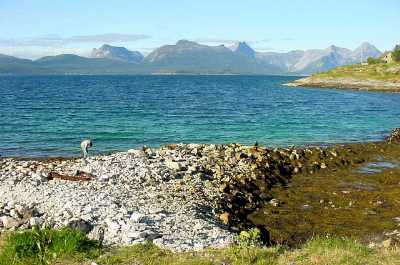 |
 |
Fig. 16 - Collecting at the Thalenite, classic locality, Tysfjord in a beautiful sunny and windy day
Fig. 17 - A superb 1,5 cm Thalenite xl embedded in Y-Fluorite
The next day we spent some time in the Kjopvisk and Drag area (Locality 2 bis on the initial map) . In Drag several quarrys are still operating for Quartz. You can collect there Pyrite, Bornite, Amazonite, Allanite but no outstanding collecting is easy for what we saw. In the Kjopvisk area several Quarrys are still operating for cement. The main Quarries are close for collecting but in the sorrounding areas large calceshists outcrops occur. Vugs occasionally occur in Calceschists and may contains outstanding Chlinoclore xls often associated with Sagenite, Quartz and Calcite xls . In one of these we collected few but outstanding Clinochlore xls associated with Sagenite and Quartz xls (Fig. 18, 19).
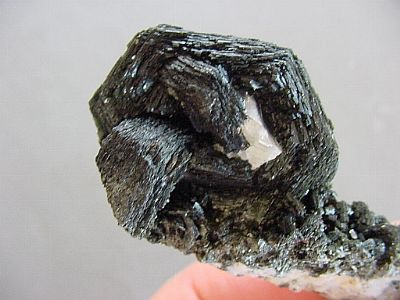 |
Fig.18 - Collecting Chlinoclore xls in a large vug near Kjopvisk, Tysfjord
Fig. 19 - A nice 2,5 cm Chlinoclore xl on matrix, Tysfjord
After the Kjopvisk area, we decided to head north passing through Narvik (Fig.20) and then driving on E6 (fig.21) to Alta and from here to reach the Seiland island to visit the famous Zirkon Locality (Locality 1 on Map 1).
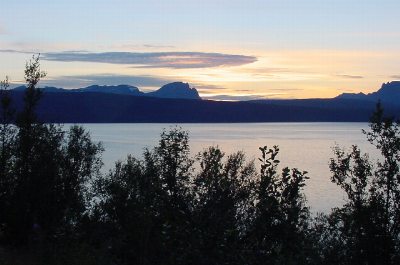 |
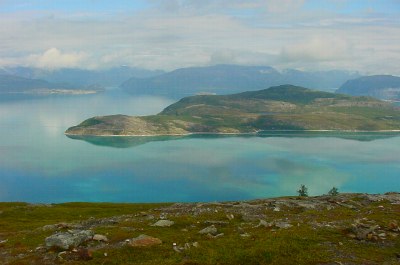 |
Fig. 20 - Sunset at Midnight at Narvik, 68O Lat. North (August 5th, 2002)
Fig.21 - Landscapes from the Large North, driving from Narvik to Alta
Seiland (Fig.22) is a very remote place to reach. Ferry connections to the continent are sporadic and random, so you may expect to wait some days on the island before you find a connection to be back (or wait some days before to go there..). No accomodations exhist so you need to organise yourself bringing with you a tent and camping facilities if you want to sleep there . Wheather conditions at Seiland may be very extreme (we are around 71O degree Lat. North ) and if you find a wrong day these may be extremely critical also in July or August time.
Zirkons in Seiland occur in a fantastic alkalin sienitic-nephelinic pegmatite that outcrops at least for 500-600 m in lenght (Fig.23). The site has been heavily exploited during the '80s and the '90s and nowadays it is extremely difficult to collect decent specimens if not spending several days and using heavy tools for collecting. Zirkons from Seiland is by far the world top for their fantastic deep orange colour with transparent and gemmy areas (see fig. 23 and 24).
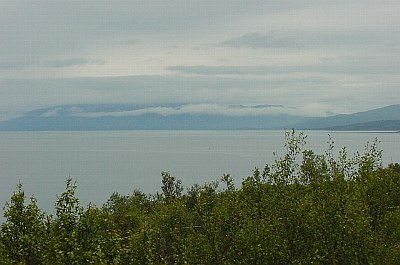 |
Fig.22 - Seiland Island from the Norwegian coast near Alta
Fig. 23 - Seiland Island, the famous Zirkon locality
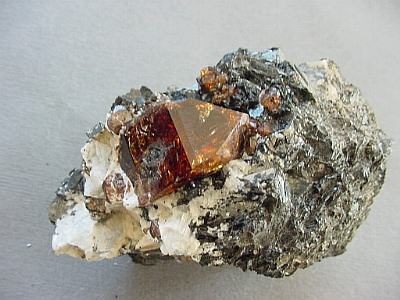 |
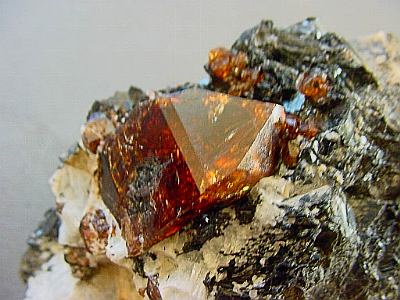 |
Fig. 24, 25 - A beautiful 3,5 cm gemmy deep orange Zirkon xl on Biotite and Nephelinite matrix from Seiland, Alta Norway
On Seiland Island other locations also produce remarkable Diopside , Thomsonite and Horneblende. Please be aware that collecting in Seiland is restricted and permit from the land owners are needed (and not garanted!) to access the collecting site. Back from Alta, where we do strongly recommend to visit the Alta Museum to see the beautiful pre-historic rupestr grapphites, we had a short stop to the old Alta Copper Mines, where some nice Native Copper has been recovered during the activities (Fig. 26) and we also have the time to familiarise with some local classic inhabitants (fig.27) (Rendeers).
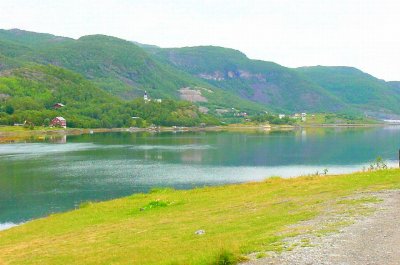 |
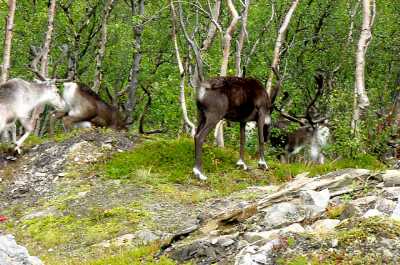 |
Fig. 26 Alta abandoned Copper Mines and Rendeers (Fig.27)
Finally we started heading to the south through Narvik, Fauske, Mo i Rana. Here we decided to take a day to visit a locality that is getting quite famous in Norway for the beautiful tremolite xls it is producing (see locality 4 on Map 1). The locality is close to the Swedish border and takes about 1 hour drive to reach it from Mo i Rana . Tremolite occurs in outcropping marble rocks concentrated in very nice xls groups to form attractive xls aggregates or in outstanding single xls. Collecting is along a lake shore on the outcropping marble rocks. Tremolite xls may reach the lenght of 10-12 cm (Fig. 28,29). Near Mo i Rana we have been also lucky to collect in an abndoned quarry some extremely nice Paligorskite specimens (see Paligorskite Gallery on Smartminerals.com )
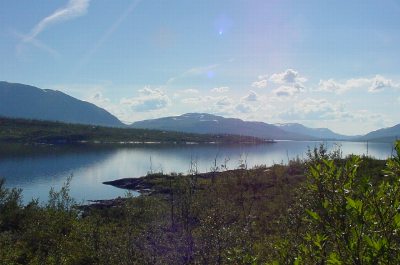 |
|
Fig. 28 - A view towards the Tremolite occurrence, near Mo i Rana, Nordland
Fig.29 Tremolite xls embedded in Marble matrix, Mo i Rana, Nordland
Continuing our trip to the south and driving through the Polar Cirkel, Mosjoen, Trondheim and Dombas we toke a stop in Oppdal Steinsenter (fig.30). The next morning we stop to visit with few success a classic Anatase locality (Sjoa, see location 5 on Map 1) between Otta and Vinstra (Fig.31). Anatase occur in small vugs in quartz veins outcropping on the river bench and along a road cut. Anatase may reach 1 cm in length and have a nice deep blu colour. Some xls may be also trasparent (please note that permit from the owner is necessary). Results from our collecting day were very poor and not relevant specimens were recovered.
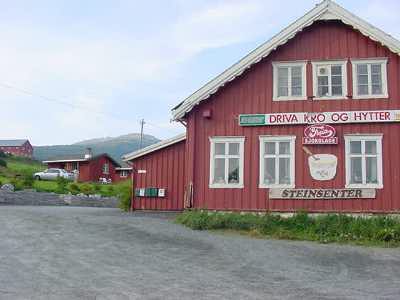 |
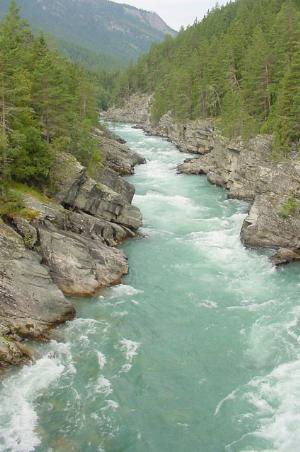 |
Fig. 30 Oppdal Krø and Steinsenter
Fig.31 The beautiful creek at Sjoa Anatase locality
After the night in Otta we decided to head to the Krøderen area to visit some of its famous Pegmatites occurrences. In one of these close to Krøderen (see location 6 on Map 1) we have been able to collect really outstanding Monazite xls on Muscovite matrix. The collecting was so successfull that we decided to stop two additional days to exploit the good monazite area we found (see fig.32,33). About 30 remarkable specimens have been succesfully recovered and packed together with other minor ones.
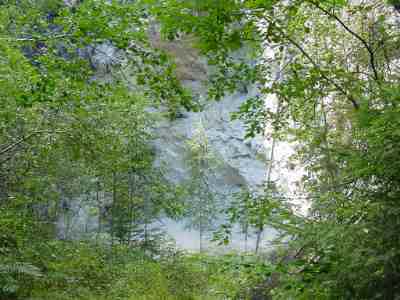 |
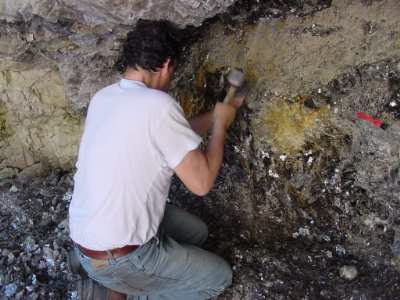 |
Fig 32 - Old pegmatite works in Krøderen where we discovered a relevant Monazite xls occurence
Fig.33 - Collecting Monazite xls in Krøderen
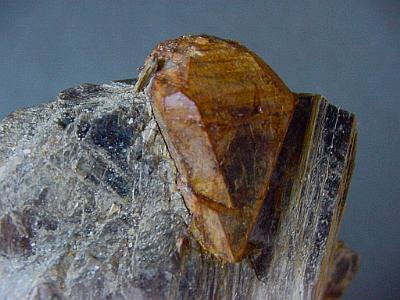 |
Fig.34 - An outstanding 3,8 cm Monazite xl on Muscovite Matrix, Krøderen, Norway
From the same starting point, we also tried to localise another old Norwegian classic: the Hydroxil-Apatite locality in Øksaugekøllen, Snarum. After one day of attempts in the dense woods we finally succeed not without difficulties in localising the small Pegmatite outcrop that have been occasionally exploited just for collecting purposes. Hydroxil Apatite occurs as sharp hexaghonal xsl over Calcite matrix or on Horneblende xls making very attractive specimens. Also very nice Horneblende may be collected at the same location (see fig. 35, 36) . In the Snarum area other interesting collecting sites exist. Among these we remember the locality of nice Hematyte xls embedded in Serpentinite. In the some area nice pseudomorphosed Olivine xls may be collected. These locations have not been visisted during our trip.
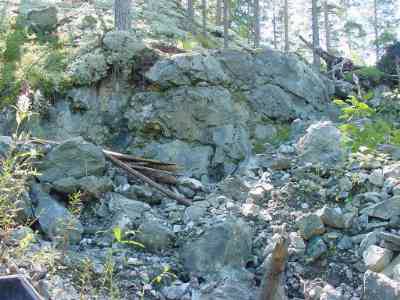 |
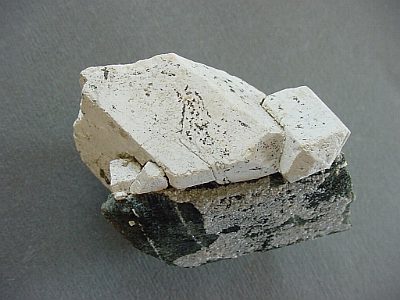 |
Fig 35 - Hydroxil-Apatite locality near Snarum
Fig.36 Hydroxil Apatite xls (4 cm) on Hornbelnede xls from Snarum, Norway
After one day of relax we start again to head south where we stop in Konsberg to visit the Mine Museum. The museum worth absolutely a visit for the fantastic (or astonishing if you like) Silver Collection that is in Exhibition (see fig. 37, 38) . There is also a small but extremely well selected Norwegian Mineralogical collection where good or excellente specimens from the most famous Norwegian locality (past and new) are well represented. If you have time the museum organise visits to the old Silver Mine several time on daily basis. The excursion takes about two hours and provide you a good idea of the size of the mining works performed during the Centuries in the Konsberg mine. More professional guided tours may be also organised by the museum on request.
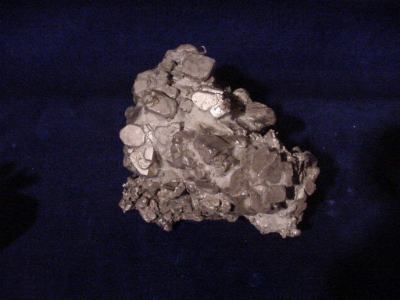 |
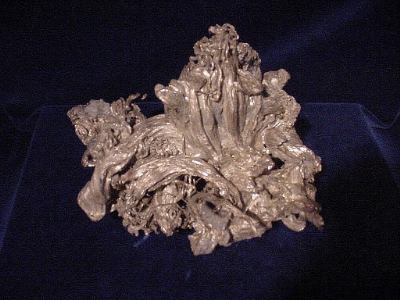 |
Fig. 37 - Silver xls (18 cm), Konsberg Museum
Fig.38 - Wire Silver (35 cm), Konsberg Musueum
After Konsberg we moved to Drammen to meet some friends (mineralogists of course) and we trade some nice Vesuvianite from a locality near Drammen. Vesuvianite apparently is quite common in the themo-metamorphosed rocks outcropping near to Drammen. Attractive deep green or brown Vesuvianite xls may be collected (Fig.39, 40) when location is known.
Fig. 39, 40 - Vesuvianite xls 3,5 and 4 cm from Drammen, Norway
After the stop in Drammen we approach the last part of our trip. The next stop was in Nissedal Area (see location 7 on Map 1) to collect in Scandium rich pegmatite of Tørdal (Hjøndalen ). These quarries are famous for the high content of Scandium and Sc _ related minerals. Cascandite, Scandium Babingtonite, Sc_Milarite, Bazzite, Kristiansenite may be collected here. The Paragenesis is very similar to that of the Baveno Area in Italy.
In one collecting day some interesting material have been recovered that still need time to be completely identified. In the same location also large Amazonites xls occurs (See fig. 41, 42) . Permit from the the various land owners are needed to access the collecting sites.
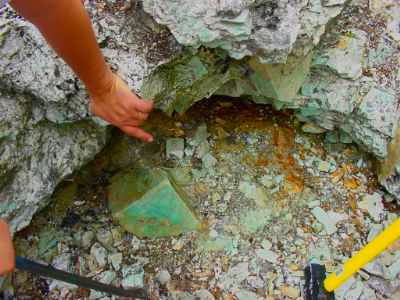 |
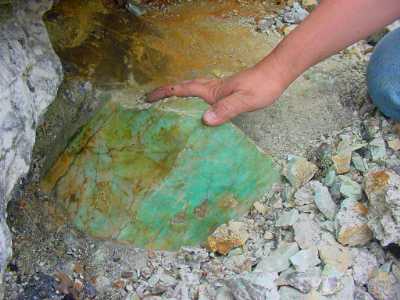 |
Fig. 41 - 42. A large (35 cm) deep green and well developed Amazonite xl in the Sc-Rich pegmatites of Nissedal
The last stop of our trip was in one of the most famous Norwegian loaclities: the Evje and Iveland areas near Kristiansand (see location 8 in Map 1). In this area that has been extensively exploited in the 19th and 20th century for Feldspar more than two hundreds abandoned pit or quarries exploiting Pegmatite veins exists. The area produced fantastic and typical Rare Eart Minerals. Among these we remember as top worldwide occurences those of Gadolinite, Thortveitite, Niobite, Aeschynite, Periklas, Columbite, Xenotime, Fergusonite etc.. . This area due to the active Setesdal people developed a quite well organised mineralogical tourism. In Evje a mineralogical trekking is possible going through the most famous quarries. For a very reasonable daily fee, you can collect what you like in the most famous Landsverk quarries area. (Fig.42-43). In Evje and Iveland also visit respectively the Evje Museum (Fig.44 - 45) and Iveland Municipality collecetion where you can get a "flavour" of the remarkable and quite unique mineralogical paragenesis of the area.
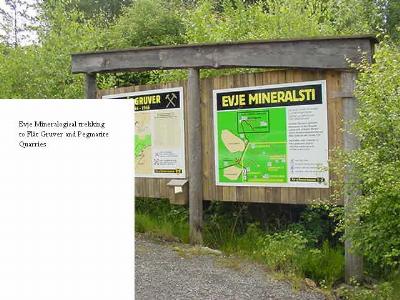 |
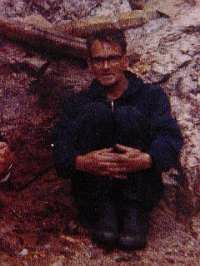 |
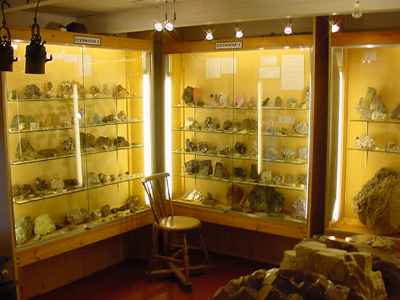 |
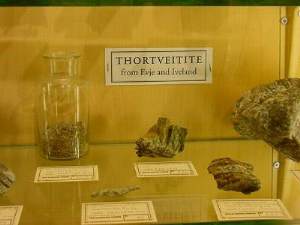 |
Fig. 42, 43 - Evje Mineralogical trekking and Landsverk Quarry
Fig.44, 45 - The Evje Mineralogical Museum and some nice Thortveitite specimens
Of course since all the quarries are now stopped, collecti relevant soecimens is quite difficult. Also to localise the differenr quarries producing the outstanding specimens of the different minerals is very diffcult. If you are determined to collect there you probably need one week or more to have some good chances of success. But of course luck is always possible. During our short stay we have been able to collect some nice Xenotime xls (Fig.46) and Blu Apatites in Iveland area and to trade and purchase some relevant Aeschynite, Gadolinite and Periklas specimens and more from an old local collection. In the same collection we also found some other classic material such as Graphite xls (fig.47) from Kragerø area , Ilmenite xls (fig. 48) from Åmdal and Horneblende from Kragerø
(see Galleries on Smartminerals.com).
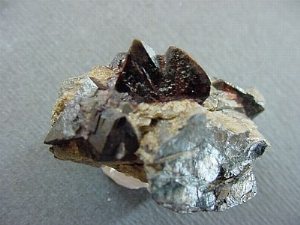  |
Fig. 46 - Xenotime xls (1 cm) from Iveland, Norway
 |
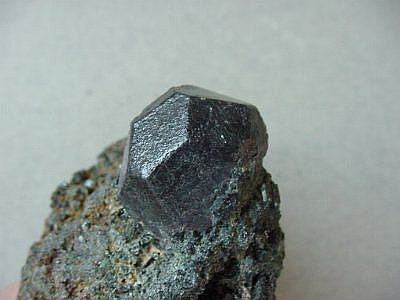 |
Fig.47 - Graphyte xl (2 cm) from Kragerø, Norway
Fig. 48 - A superb (2 cm) Ilmenite xl from Åmdal, Frøland, Norway
After 20 days, 6300 Km, 17 Ferrys our trip ended in Kristiansand where we toke the ferry back to Denmark. As you probably see we didn't visit for lack of time some of the classic Norwegian localities such Langesundfjord, Bamble, Kragerø, Åmdal....... but we have plans to be back in a near future and to complete and expand our knowlwdge of the Norwegian Mineralogy and complete our section .
What to say more..? We enjoy every day of our stay in Norway. Despite our pessimistic initial forecasts we just have three days of rain over 20 days of trip and nice temperatures also in the Far North. May be we have been lucky ...... .We hope you also enjoy our short summary as well as our galleries in the Scandinavian Section..... If you want to go there sometime remember that Norway is an expensive country and the budget for the trip should be adequate...... .
Recommended months are June and July if possible or August as a second choice, good luck !.